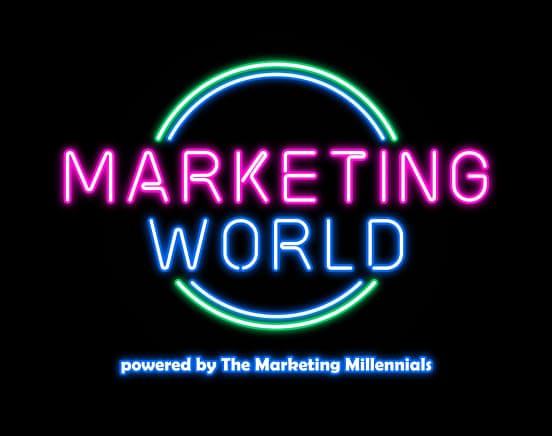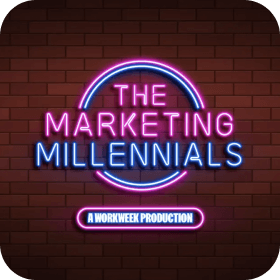It is tough out there right now. Tight budgets, layoffs, and a bumpy road ahead.
But this isn’t today’s guest’s first rodeo.
Marketing Bestie, meet Robin Daniels.
A 3x CMO (yes, 3x) with over 20 years in Marketing and Growth roles has led some of the biggest brands through shaky economic times in 2000 and 2008.
Here’s what Robin had to say on how to stay ahead of the competition in a downturn on The Marketing Millennials Podcast, in his own liiightly edited words.
1. Marketing in a downturn:
“Don’t freak out.
Yes, we’re certainly going through some really big challenges right now. Every dollar that is being spent on marketing is being scrutinized a little bit more.
What that means is you need clarity and alignment on what it is that you’re trying to achieve.
The random acts of marketing won’t fly anymore (*cries in Marketing*).
Also, the brand campaigns to create your category or movement are going to be scrutinized.
It’s very hard to measure the exact impact of a big brand campaign on revenue.
There are great metrics out there, but anybody who tells you they can measure exact output from a brand campaign to revenue is lying to you.
You need to put more focus on putting out things that are directly measurable and will lead to outcomes that can grow the business in a sustainable and predictable way.
Digital is the easiest way to do that.
However, in an environment where you have limited, reduced, or even no budget, focusing on creating differentiation through great content is posing as a HUGE opportunity.
You have to be super creative with your content, it doesn’t mean posting on your blog. Try video, audio, e-books, or a documentary (and MEMES).
Level up your marketing game
Zero BS. Just fun, unfiltered, industry insights with the game-changers behind some of the coolest companies from around the globe.
No spam. Unsubscribe any time.
There are a lot of great creators who are rethinking the creation and distribution of content (distribution is half the battle!!).
To any company who’s going through tough times, focusing on content the next 2 years will be huge.
2. Startups make this mistake:
When you’re a startup, you have to figure out your path to move up the chain of competition.
Small startup companies make the mistake of instantly talking about the movement they’re trying to create and the change they’re going to make in the world.
Consumers don’t want to hear that right now. They want to know how you’re going to make their life better every single day.
Don’t jump the gun on moving up the chain too quickly. If you’re Apple, Airbnb, or Tesla, you’ve proven yourself over decades and you can compete on that level, startups can’t.
As a startup you need to educate people to ultimately fall in love with who you are and what your product is. Emphasize how this feature will make your customer’s life easier (LOVE this).
A great example of this is Expensify. They took a feature that seemed fairly simple, but they made it elegant and easy to use (ily Expensify).
Over time they ended up dominating the category of expense management. Now they’re huge and manage all of your company’s budgets.
But they didn’t start there. If you start too quickly at a high level, you’re just going to lose people.
How do you get people to fall in love with you through a downturn?
Think about the journey of moving your customers through those different stages.
The higher up you move, the more revenue and loyalty you generate.
If you only compete in the feature level, the moment a better feature comes along, your customers are gone. You haven’t earned loyalty.
But companies need to understand, this takes time to do (literally screaming this from the rooftops).
3. When to pivot your brand:
Small companies tend to pivot too quickly.
They don’t have enough conviction in their strategy. So every six months, they change it.
It’s a hard balance because you want to be agile.
Agility is a key part of having a modern business, but if you’re changing your messaging and go-to-market strategy every 3-6 months you’re confusing your buyer (this needs to be said).
Building your brand requires focus, consistency, and time. It doesn’t happen overnight.
The tension you’re seeing with marketing teams today is they’re being tasked with creating a new category and building a brand that people fall in love with, but also being asked for results ASAP.
The executive team needs to know it takes time to put out content and create a brand. This doesn’t happen in days, weeks, or even quarters.
We’re talking years. Very few people have the patience to do so.
But all the brands that have been actually going for a while are CRUSHING. Think Patagonia and Airbnb.
They’ve been very consistent in how they’ve gone to market for a long time.
Yes, they do modify to be more relevant to what’s happening in the market, but they’re fairly consistent time after time.
And you can’t reach that if you’re a marketing team constantly pivoting to the latest, hottest thing (every single brand using TikTok rn – LOL).
4. The best way to test something instantly:
This is why I love digital.
It’s fast and gives you a ton of data to optimize your plan ahead.
If you want to start something Monday or Tuesday, by the end of the week, you’ll have a boatload of data and you don’t have to put that much money into it.
You get results and great data.
Then you can go to your CMO or CEO and say, “here’s what we’re going to do based on the data that we’re seeing.”
You don’t have to spend $100K to do so, you can spend $500-$1,000.
Digital is the best way to test something nearly instantly.
5. Your marketing strategy should be this:
The best marketing strategies are a mix of different things.
First being digital. You get fast results, lots of data, but it is easy to over rely on.
Especially in B2B, you get a lot of crap inbound, which means you’re wasting money or trust with your sales team by giving them leads that are not the best quality (when Marketing and Sales are aligned>>>).
The second is content. Content is amazing, but requires a lot of thought in what your differentiation is, what’s your storyline? How are you going to distribute it?
You’re not going to get instant results there. But it’s one of the best ways to create that momentum in your business.
Then finally to create that movement that people fall in love with, think of community-based marketing, word of mouth marketing, event marketing.
Where you get in front of your customers or they self-organize. Encourage that (YESS).
Word of mouth is one of the best ways to create love and loyalty.
Guess what? That also takes the longest of all them. But that’s where you’re going to get your best customers.
You’ve got digital which is fast, organic and content marketing which is medium speed, and then community marketing which is slower.
A good marketing strategy has to contain all of them. If you silo yourself into one, you’re setting the team up for failure.
If you just want to create a transactional brand that nobody really cares about, invest all your money in digital.
But to create a brand that stands the test of time, you have to invest in all three.”



